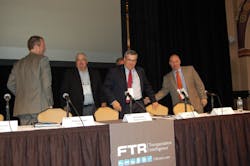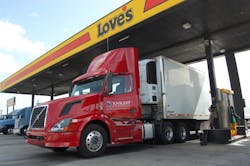INDIANAPOLIS. There will be no shortage of challenges ahead for the trucking industry over the next few years, according to comments made by motor carrier executives and analysts gathered here at research firm FTR’s annual transportation conference.
Noël Perry, an FTR partner and its resident trucking expert, said the industry can expect only around 2% gross domestic product (GDP) U.S. economic growth for the next two or three years, with a 30% to 40% likelihood of a recession within the next three years.
“We’re not forecasting a recession; we’re just worried about it,” Perry stressed during his economic overview of trucking. “Don’t go into the bunker in 2017. But you need to have a recession plan in your back pocket; you need to plan for that exposure.”
He added that the next five years “are going to be extremely uncertain and dynamic” for motor carriers. “It’s not going to be business as usual.”
Eric Starks, FTR's president & CEO, said that North American Class 8 production should end 2016 at about 230,000 units and only increase to 231,000 units in 2017, with the "flat" nature of freight volumes further complicating the picture for trucking.
"Flat is difficult; the trucking industry doesn't like flat," Starks explained. "It's used to growth or decline; events you can take action upon. With flat, you do nothing and you don't think positive thoughts, either. You are waiting for the other shoe to drop."
John Culp, responsible for the financial, human resources, information technology and maintenance departments for Maverick Transportation, noted that freight volumes “are a little soft” at the moment compared to last year. “They are not bad but not good; this year it’s been basically more of the same,” he said.
Jason Seidl, a managing director at Wall Street analysis firm Cowen Group, added that freight is not only soft but is leading to “confusion about what direction it wants to go in; there are days when our clients say they have too few trucks and others when they have too little freight.”
The impact of regulatory initiatives is another worry, especially in terms of productivity losses.
For example, most of the carriers speaking at FTR’s annual conference implemented electronic logging devices (ELDs) years ago, yet in many cases still haven’t recovered from the productivity hit from doing that.
“We adopted ELDs several years ago but we’ve not overcome the 4% to 5% productivity loss, even though we were highly complaint [with hours of service rules] on paper logs,” explained Mark Rourke, executive vice president and COO with TL carrier Schneider.
“We sit here in 2016 and we’re still not back from that, though we’ve recovered some of that loss on yields,” he added. “We’ve had to re-engineer our network.”
Rourke also noted that Schneider lost between 300 to 350 owner-operators from its system who didn’t want to use ELDs.
Maverick’s Culp noted his company fully implemented ELDs back in 2011 and found fleet mileage dropped as a result, falling from an average of 480 miles per day in 2006 down to 414 miles per day down to 414 in 2011 or 16%. Today, daily mileage is “holding steady” at 425 per day.
“When you look at our four year average, our productivity is down around 5.5%,” he said. “But we recovered about 2% of that because the electronic data we get [from ELDs] helps us plan better.”
Cowen’s Siedl noted that, based on his firm’s analysis, when the ELD is fully implemented in Dec. 2017, trucking industry productivity should fall about 4.8% overall.
Equipment costs are another big issue as the recent decline in used truck prices is significantly affecting residual values.
Complicating that picture, noted David Williams, vice president at Knight Transportation, is that cheaper used trucks help buttress more lower-cost competition especially in the TL segment.“We’re buying a new truck for $120,000 and when we trade it out in three or four years, it’s going for $40,000 and that gives a secondary buyer a lower cost structure to undercut us,” he explained. “That’s a challenge for us moving forward.”
Williams added that exhaust emission control mandates spanning from 2002 through 2010 added $20,000 to $25,000 to a new truck’s sticker price on the front end, which often cannot be fully recovered on the back end.
And he believes that pricing gap will only widen as Phase 2 greenhouse gas (GHG) rules are implemented, adding more cost to Class 8 trucks.
Williams said the "governments' math" indicates Phase 2 GHG technology will add $12,000 to the base cost of a Class 8 tractor. "But if you add up the price of each piece of technology they’re talking about separately, it's about $20,000," he said. "That's why we think the ROI [return on investment] will not be as good as it’s being claimed to be. And that also means the first time buyer will see more added cost much earlier than the secondary buyer.”
Yet Williams also noted that the imposition of ELDs should help reduce the ability to engage in such “undercutting” going forward.
“Carriers with trucks logging 4,000 miles a week by breaking the [hours of service] rules add to available capacity,” he explained. “That’s why we want everyone on ELDs; it will stop the cheating, make everyone safer on the road, and cut down on the capacity supply.”
About the Author
Sean Kilcarr
Editor in Chief
Sean Kilcarr is a former longtime FleetOwner senior editor who wrote for the publication from 2000 to 2018. He served as editor-in-chief from 2017 to 2018.



